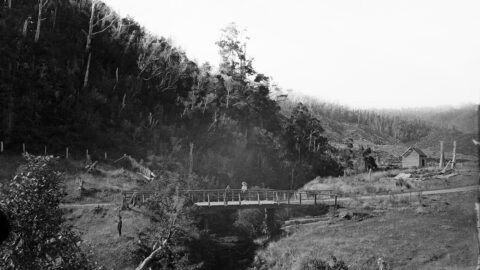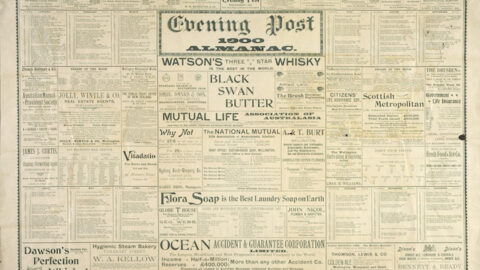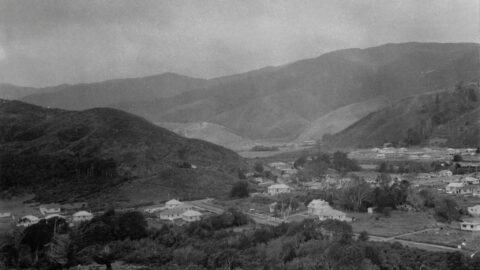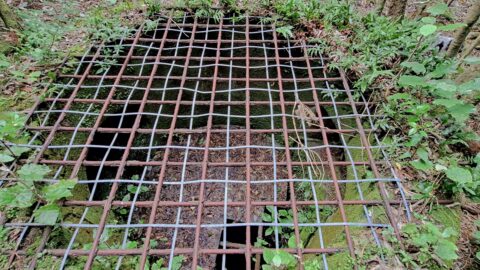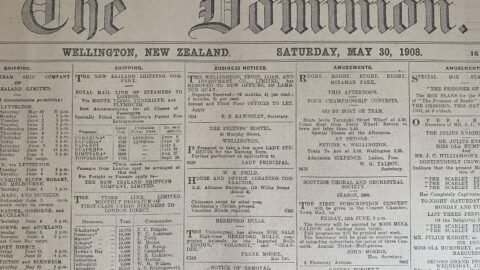THE WAINUI-O-MATA WATER WORKS.
AN ENGINEER’S REPORT.
At our request Mr Nicholas Merchant, C.E., has made a special inspection of the Wainui-o-mata Waterworks. The following is his report:—
Much has been both written and said re the condition of the Wainui-o-mata Waterworks. Were it not so serious it would be amusing (also, in another sense, possibly instructive) to follow up the opinions expressed and the qualifications of the would-be advisers. However, that is altogether out of my line.
Also, it is out of my line to descant in this report upon the beauty, barrenness, or otherwise of the Wainui-o-mata Valley; my work consists in collecting hard, dry facts, and grinding them down in such manner that the result may prove a series of instructive figures. This being the case, I shall attempt no description of the district or works, premising that through the medium of the NEW ZEALAND TIMES the public have a fair general idea of the waterworks and valley.
THE CONCRETE RACE
I propose then to commence at once with the concrete race. Readers of the NEW ZEALAND TIMES will hardly require reminding that the race is a waterway connecting the reservoir with the concrete well (pressure regulator), the latter being in connection with the cast-iron mains which convey the water to Wellington.
The race is nearly a mile and a quarter long, laid down in a sidling road cut on the northern side of the valley, following the sinuosities of the hill sides, and constructed apparently wholly of Portland cement concrete.
The culvert is 3ft 9in wide, arched over, and having an invert the versed sine of which is about six inches. The full height I am not sure about, but from memory should say it about equals the width. This race has been loudly condemned as lacking stability, and leaking badly. I had to discover if such was substantially true.
To do so I just traversed the reservoir road, which runs between the race and the river, carefully scanning every inch of the ground on my left, or race side — starting, I must state, from the well end — thence returning after having reached the reservoir along the sidling track over the race and back to the well, returning finally to the reservoir by way of the river bed and banks.
It must be understood that the reservoir road level is considerably below the level of the race for the most part, and the river lower still; hence water breaking from the race soon discovers itself by gravitating to the road or the river. At a point in the river immediately opposite the well the flow largely exceeded my expectations, but I soon found a considerable stream issuing from a gully on my right or the south bank, and, as I may as well finish with this bank, I will simply state that between the well and the reservoir three other streams from gullies in that direction were flowing into the Wainui-o-mata River, but the whole collectively were not of such volume as to account for the fact that the river flow opposite the well exceeded my expectations.
As I progressed up the river, I examined the banks, more especially the northern one, expecting every moment, and at every turn and bend, signs of leakage from the race, finding none until within about 25 chains of the reservoir custodian’s house, built on the reservoir bank.
From this point, upward leaks manifested themselves on the north side — river bank, road and race alike — but ceased about six or seven chains from the reservoir. To my surprise, however, a stream of decent volume still continued to flow at my feet, and as I journeyed on, turning a bend in the river immediately under the reservoir bank, I came upon the solution of the mystery.
THE GREAT LEAK
The flow was due to a faulty sludge channel sluice, and of course the water was coming direct from the reservoir. Nothing having been said about this in the Council reports, and all blame having been thrown on the unfortunate race, I felt disgusted.
I had been forming theory after theory as I trudged along to account for the flow, only to find all exploded by the fact that the hole was caused by either stupid blundering or neglect. I see it has been stated that the loss from the sludge channel equalled a million gallons per diem. I think this estimate largely in excess.
The discharge is a difficult one to fairly calculate, but I put it at about 687,221 gallons per diem. Taking the population of Wellington at 26,000 souls, it alone would furnish a supply of upward of 26 gallons per head per diem — no insignificant loss.
LOSS FROM THE RACE LEAK
Finding this unexpected waste from the reservoir direct, I turned my attention to the race itself, to determine, if possible, the extent of loss the leaks occasioned, and here I may state that the most serious one had been repaired. This crack, I was informed, was fully 25ft long, and of sufficient width at points that a hand held flat could be inserted. This would give an opening of about three quarters of an inch.
I noticed that in spite of the repairs the leak was to some extent still active.
The observations on the race were chiefly made at each end, in order to determine what amount of water entered the race from the reservoir, and what quantity was discharged from it at the well end.
The quantities stand thus:
Gallons of water entering race: 1,868,400
Gallons of water discharged at well: 1,701,000
Difference: 167,400
Now this difference represents the loss by leakage — of course, I am ready to admit, if my observations were correctly made, I know of circumstances that may, apart from leakage, cause an apparent loss; but with serious leaks before me, that I dare not estimate by eye and other methods denied, I feel convinced the foregoing figures must approximate very closely.
This loss of 167,400 gallons of water is about 6½ gallons per head of population, and, when added to the loss caused by the sludge sluice, gives a total loss of 32½ gallons per head per diem for the estimated population of the city of Wellington; putting water for power aside, no insignificant town supply.
Before leaving the race, I must, I suppose, say something about the concrete.
To the queries, whether it is fairly good or very bad, I will reply that only small patches of the race have been uncovered, and these but few in number; but were I compelled to judge of the whole sampling from the exposed parts, I should say it was of very indifferent quality indeed.
It would be difficult to gainsay the assertion that the full and proper proportion of cement was used. That may be perfectly true, and yet the result may be wretched stuff. Other conditions — cement apart — are lacking to constitute good concrete. Before seeing the now celebrated crack — the 25ft one — I felt rather at a loss to account for its being longitudinally along the race rather than transverse, or nearly so.
An inspection soon explained the reason. The race at this point spans a small gully. A flume and shaft were built to convey the gully water under the race, over which a short embankment was carried to receive the race. The embankment has slightly subsided, probably caused by a fault in the flume, and the invert of the race has also sunk, the sides and crown remaining in their original position from abutment to abutment, as would be the case with a beam or truss.
THE RESERVOIR
Under this head I shall treat principally of the quantity of water flowing into it at the time of my visit, and may also make a few remarks pertinent thereto.
The level of the water was 61 inches below the level of the by-wash or normal height, detracting greatly from the appearance of the basin, and exposing to view unsightly mud islands.
Skirting the basin, I went about two miles upstream on the south bank, everything looking very parched and thirsty, and the stream small. Returning I made notes of the flow into the reservoir, over a weir constructed for the purpose. I found the inflow to be about 2,500,000 gallons. It is freely stated to be much more — I take no notice of that.
The weir is, on the whole, well-positioned and, for summer flows passing over it, of suitable dimensions so far as regards length and depth; but more than this cannot be said of it; for giving reliable results it is worse than useless.
As a good weir is of great service at times, one should be constructed and of a permanent character. Water is extremely sensitive, and where accurate results are required must be treated with judgment.
But to return to the 2,500,000 gallons inflow. Though of itself sufficient for a population of 50,000 consuming 50 gallons per head per diem, it to me appears the most alarming feature of the whole case. Either the water-yielding characteristics of the valley are greatly altering, or the yield has been grossly exaggerated in the past.
Petone was to draw from it, Lower Hutt to be supplied. Is it safe to allow either? That is not for me to say, but of this I am convinced, the day is nearer than most people think when water must cease to be distributed for power in Wellington all the year round, unless the gathering grounds are largely extended or storage works of large capacity constructed.
THE WELL
This structure of concrete, 8ft. diameter internally, and upward of 60ft. deep, was designed to regulate the pressure on the mains. This duty it fails to perform at all times, owing to insufficiency of supply from the race. During times of slack-water, and when the fall is considerable in the well, the result must be to distress the mains, but to what extent can only be known by experimental tests.
I look on this well as being of very doubtful advantage. One weak feature is this: It fails at maximum point to regulate the pressure without waste. With an iron stand-pipe connected by iron mains to the reservoir this fault could have been avoided.
CONCLUSION
In conclusion I need only point out that I am aware my figures show an error if any attempt be made to balance them precisely. Minute accuracy is impossible where data are of such a character; but my figures may safely be taken as a very close approximation.
I forgot to mention when dealing with the well, that the discharge into it was equal on Saturday last, when the pressure was so low, to 65 gallons per head for 26,000 people. There must be either a scandalous waste of water in the city, or, what is not very probable, great loss in the pipe-track between the city and the source.
Nicholas Marchant, C.E.
Tags: Dams Lower Dam Newspaper Water Race Waterworks
